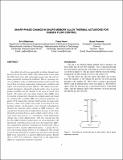Sharp Phase Change in Shape Memory Alloy Thermal Actuators for Subsea Flow Control
Author(s)
Gilbertson, Eric W.; Freeman, Bryan; Hover, Franz S.
DownloadHover_Sharp phase.pdf (508.2Kb)
OPEN_ACCESS_POLICY
Open Access Policy
Creative Commons Attribution-Noncommercial-Share Alike
Terms of use
Metadata
Show full item recordAbstract
Gas-lifted oil wells are susceptible to failure through malfunction of gas lift valves (GLV). One failure mode occurs when the GLV check valve fails and product passes into the well annulus, potentially reaching the wellhead. This is a growing concern as offshore wells are drilled thousands of meters below the ocean floor in extreme temperature and pressure conditions and repair and monitoring become difficult. The authors have previously developed a thermally-actuated safety valve to prevent product backflow into the annulus in the event of check valve failure. The safety valve uses shape memory alloy (SMA) wires to translate a temperature change into a displacement and, based on commercially available SMA wire material properties, requires a 6°C temperature change to fully actuate. In some wells, however, check valve failure may result in less than 6°C temperature change. In this paper a new concept is developed to sharpen the austenitic phase change in SMA actuators. The concept has broad practical implications because it will allow thermally-activated devices, such as fluid control valves, to become much more precise, i.e., translating a small temperature change into a large displacement. The new concept uses the fact that SMA transition temperatures are stress dependent. By specifically controlling stress in the wire, the temperature difference required for austenitic transition can be decreased. This is achieved with a negative-differential spring — a spring that exerts a decreasing amount of force as it is displaced. The concept is tested experimentally by conductively and electrically heating SMA wires connected to a negative-differential spring. Results show a 2.9°C-5°C reductions, respectively, in the temperature difference required for austenitic transition.
Date issued
2012-07Department
Massachusetts Institute of Technology. Department of Mechanical EngineeringJournal
Proceedings of the ASME 2012 31st International Converence on Ocean, Offshore and Arctic Engineering
Publisher
American Society of Mechanical Engineers
Citation
Gilbertson, Eric, Franz Hover, and Bryan Freeman. “Sharp Phase Change in Shape Memory Alloy Thermal Actuators for Subsea Flow Control.” ASME 2012 31st International Converence on Ocean, Offshore and Arctic Engineering. Volume 6: Materials Technology; Polar and Arctic Sciences and Technology; Petroleum Technology Symposium (July 1, 2012).
Version: Author's final manuscript
ISBN
978-0-7918-4493-9